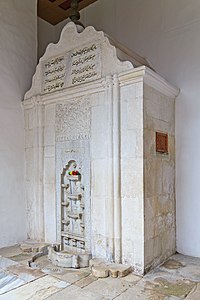Crimean Khanate
Throne of Crimea and Desht-i Kipchak | |||||||||||
|---|---|---|---|---|---|---|---|---|---|---|---|
| 1441–1783 | |||||||||||
 The Crimean Khanate in 1502 | |||||||||||
| Status | Khanate[a] | ||||||||||
| Capital | |||||||||||
| Common languages |
| ||||||||||
| Government | Elective monarchy | ||||||||||
| Khan | |||||||||||
• 1441–1466 | Hacı I Giray (first) | ||||||||||
• 1777–1783 | Şahin Giray (last) | ||||||||||
| History | |||||||||||
• Established | 1441 | ||||||||||
| 1783 | |||||||||||
| Currency | Akçe | ||||||||||
| |||||||||||
| Today part of | |||||||||||
The Crimean Khanate[b] self-defined as the Throne of Crimea and Desht-i Kipchak[4][c] and in old European historiography and geography known as Little Tartary[d], was a Crimean Tatar state existing from 1441–1783, the longest-lived of the Turkic khanates that succeeded the empire of the Golden Horde. Established by Hacı I Giray in 1441, it was regarded as the direct heir to the Golden Horde and to Desht-i-Kipchak.[5][6]
In 1783, violating the 1774
Naming and geography

The Crimean Khans, considering their state as the heir and legal successor of the
According to Oleksa Hayvoronsky, the inhabitants of the Crimean Khanate in Crimean Tatar usually referred to their state as "Qırım yurtu, Crimean Yurt", which can be translated into English as "the country of Crimea" or "Crimean country".[10][11]
English-speaking writers during the 18th and early 19th centuries often called the territory of the Crimean Khanate and of the Lesser Nogai Horde Little Tartary (or subdivided it as Crim Tartary (also Krim Tartary) and Kuban Tartary).[12] The name "Little Tartary" distinguished the area from (Great) Tartary – those areas of central and northern Asia inhabited by Turkic peoples or Tatars.
The Khanate included the
History
Pre-history
The first known
In the Horde period, the khans of the Golden Horde were the Supreme rulers of the Crimea, but their governors –
The multi-ethnic population of Crimea then consisted mainly of those who lived in the steppe and foothills of the Peninsula:
Horde rule for the peoples who inhabited the Crimean Peninsula was, in general, painful. The rulers of the Golden Horde repeatedly organized punitive campaigns in the Crimea when the local population refused to pay tribute. An example is the well-known campaign of the Nogai Khan in 1299, which resulted in a number of Crimean cities suffering. As in other regions of the Horde, separatist tendencies soon began to manifest themselves in Crimea.
In 1303, in Crimea, the most famous written monument of the Kypchak or Cuman language was created (named in

There are legends that, in the 14th century, the Crimea was repeatedly ravaged by the army of the
During the reign of Canike Hanım, Tokhtamysh's daughter, in Qırq-Or, she supported Hacı I Giray in the struggle against the descendants of Tokhtamysh, Kichi-Muhammada and Sayid Ahmad, who as well as Hacı Giray claimed full power in the Crimea[25] and probably saw him as her heir to the Crimean throne.[26] In the sources of the 16th–18th centuries, the opinion according to which the separation of the Crimean Tatar state was raised to Tokhtamysh, and Canike was the most important figure in this process, completely prevailed.[27]
Establishment
The Crimean Khanate originated in the early 15th century when certain clans of the
Ottoman protectorate

The sons of Hacı I Giray contended against each other to succeed him. The Ottomans intervened and installed one of the sons, Meñli I Giray, on the throne. Menli I Giray, took the imperial title "Sovereign of Two Continents and Khan of Khans of Two Seas."[29]
In 1475 the Ottoman forces, under the command of
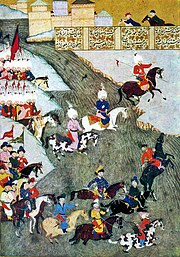
In 1475, the Ottomans imprisoned Meñli I Giray for three years for resisting the invasion. After returning from captivity in
Victory over the Golden Horde
In 1502, Meñli I Giray defeated the last khan of the Great Horde, which put an end to the Horde's claims on Crimea. The Khanate initially chose as its capital Salaçıq near the Qırq Yer fortress. Later, the capital was moved a short distance to Bahçeseray, founded in 1532 by Sahib I Giray. Both Salaçıq and the Qırq Yer fortress today are part of the expanded city of Bahçeseray.
Slave trade
The slave trade was the backbone of the economy of the Crimean Khanate.[34][35]
The Crimeans frequently mounted raids into the
For a long time, until the early 18th century, the khanate maintained a massive
Author and historian Brian Glyn Williams writes:
Fisher estimates that in the sixteenth century the Polish–Lithuanian Commonwealth lost around 20,000 individuals a year and that from 1474 to 1694, as many as a million Commonwealth citizens were carried off into Crimean slavery.[40]
Early modern sources are full of descriptions of sufferings of Christian slaves captured by the Crimean Tatars in the course of their raids:
It seems that the position and everyday conditions of a slave depended largely on his/her owner. Some slaves indeed could spend the rest of their days doing exhausting labor: as the Crimean vizir (minister) Sefer Gazi Aga mentions in one of his letters, the slaves were often "a plough and a scythe" of their owners. Most terrible, perhaps, was the fate of those who became galley-slaves, whose sufferings were poeticized in many Ukrainian dumas (songs). ... Both female and male slaves were often used for sexual purposes.[39]
Alliances and conflicts with Poland and Zaporozhian Cossacks

The Crimeans had a complex relationship with
Struggle with Muscovy

In the middle of the 16th century, the Crimean Khanate asserted a claim to be the successor to the Golden Horde, which entailed asserting the right of rule over the Tatar khanates of the Caspian-Volga region, particularly the
Don Cossacks reached lower Don, Donets and Azov by the 1580s and thus became the north-eastern neighbours of the khanate. They attracted peasants, serfs and gentry fleeing internal conflicts, over-population and intensifying exploitation. Just as Zaporozhians protected the southern borders of the Commonwealth, Don Cossacks protected Muscovy and themselves attacked the khanate and Ottoman fortresses.[44][45]
Relationship with Circassians
Under the influence of the Crimean Tatars and of the Ottoman Empire, large numbers of Circassians converted to Islam. Circassian mercenaries and recruits played an important role in the khan's armies, khans often married Circassian women and it was a custom for young Crimean princes to spend time in Circassia training in the art of warfare.[46] Several conflicts occurred between Circassians and Crimean Tatars in the 18th century, with the former defeating an army of Khan Kaplan Giray and Ottoman auxiliaries in the battle of Kanzhal.[47]
Decline
This section needs additional citations for verification. (November 2016) |
The

The decline of the Crimean Khanate was a consequence of the weakening of the Ottoman Empire and a change in Eastern Europe's balance of power favouring its neighbours. Crimean Tatars often returned from Ottoman campaigns without loot, and Ottoman subsidies were less likely for unsuccessful campaigns. Without sufficient guns, the Tatar cavalry suffered a significant loss against European and Russian armies with modern equipment. By the late 17th century, Russia became too strong for Crimean Khan to pillage and the Treaty of Karlowitz (1699) outlawed further raids. The era of great slave raids in Russia and Ukraine was over, although brigands and Nogay raiders continued their attacks, and consequently Russian hatred of the Crimean Khanate did not decrease. These politico-economic losses led in turn to erosion of the khan's support among noble clans, and internal conflicts for power ensued. The Nogays, who provided a significant portion of the Crimean military forces, also took back their support from the khans towards the end of the empire.
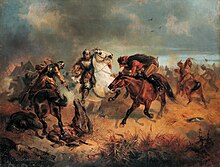
In the first half of the 17th century,
The united Russian and Ukrainian forces attacked the Crimean Khanate during the
More warfare ensued during the reign of
The rule of the last Crimean khan Şahin Giray was marked with increasing Russian influence and outbursts of violence from the khan administration towards internal opposition. On 8 April 1783, in violation of the treaty (after some parts of treaty had been already violated by Crimeans and Ottomans), Catherine II intervened in the civil war, de facto annexing the whole peninsula as the Taurida Oblast. In 1787, Şahin Giray took refuge in the Ottoman Empire and was eventually executed, on Rhodes, by the Ottoman authorities for betrayal.[49] The royal Giray family survives to this day.
Through the 1792
Government
All Khans were from the
Internal affairs
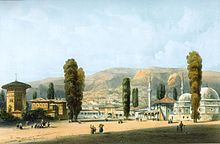
Internally, the khanate territory was divided among the beys, and beneath the beys were
Crimean law

Crimean law was based on Tatar law, Islamic law, and, in limited matters,
Non-Muslim minorities

Substantial non-Muslim minorities –
The Jewish population was concentrated in Çufut Kale ('Jewish Fortress'), a separate town near Bahçeseray that was the Khan's original capital. As with other minorities, they spoke a Turkic language. Crimean law granted them special financial and political rights as a reward, according to local folklore, for historic services rendered to an uluhane (first wife of a Khan). The capitation tax on Jews in Crimea was levied by the office of the uluhane in Bahçeseray.[51] Much like the Christian population of Crimea, the Jews were actively involved in the slave trade. Both Christians and Jews also often redeemed Christian and Jewish captives of Tatar raids in Eastern Europe.[39]
Economy
The
The
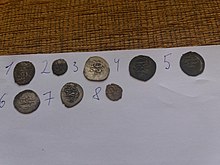
Crimean art and architecture
Selim II Giray fountain
The
Bakhchisaray Fountain

One of the notable constructors of Crimean art and architecture was Qırım Giray, who in 1764 commissioned the fountain master Omer the Persian to construct the Bakhchisaray Fountain. The Bakhchisaray Fountain or Fountain of Tears is a real case of life imitating art. The fountain is known as the embodiment of love of one of the last Crimean Khans, Khan Qırım Giray for his young wife, and his grief after her early death. The Khan was said to have fallen in love with a Polish girl in his harem. Despite his battle-hardened harshness, he was grievous and wept when she died, astonishing all those who knew him. He commissioned a marble fountain to be made, so that the rock would weep, like him, forever.[55]
-
Fountain of Selim II Giray
-
The Bakhchisaray Fountain
Regions and administration
The nine regions outside of Qirim yurt (the peninsula) were:
- Kaztsiv ulus (located in Kuban)
- Yedychkul Horde
- Djambayluk Horde
- Yedisan Horde
- Budjak Horde
- Prohnoinsk Palanka (possibly leased to the Zaporizhian Host) (located on the Kinburn peninsula)
- Bakhchisaray
The peninsula itself was divided by the khan's family and several beys. An estate controlled by a bey was called a beylik. Beys in the khanate were as important as the Polish
Part of the main khan's estates were the lands of the Kalga who was next in the line of succession of the khan's family. He usually administered the eastern portion of the peninsula. The Kalga was also Chief Commander of the Crimean Army in the absence of the Khan. The next administrative position, called Nureddin, was also assigned to the khan's family. He administered the western region of the peninsula. There also was a specifically assigned position for the khan's mother or sister — Ana-beim — which was similar to the Ottomans' valide sultan. The senior wife of the Khan carried a rank of Ulu-beim and was next in importance to the Nureddin.
By the end of the khanate regional offices of the kaimakans, who administered smaller regions of the Crimean Khanate, were created.
- Or Qapı (Perekop) had special status. The fortress was controlled either directly by the khan's family or by the family of Shirin.
Ottoman Empire territories
- Kefe Eyalet, a seat of Ottomans in Crimea until 1774
- Danube Vilayet
See also
|
|
|
|
Notes
- ^ De facto independent, de jure vassal of the Ottoman Empire from 1475 to 1774.
- ^ Qırım Hanlığı), قریم خانلغى.
- ^ Taht-i Qırım ve Deşt-i Qıpçaq, تخت قريم و دشت قپچاق). Other names include: Ulu(g) Orda lit. 'Great Horde'; Ulu(g) yurt lit. 'Great yurt'; Qırım yurt lit. 'Crimean yurt'.
- Latin: Tartaria Minor.
References
- ^ Archive
- ^ Türkiye Diyanet Vakfı İslâm ansiklopedisi (in Turkish). Vol. 14. 1996. p. 77.
- ^ "CHAGHATAY LANGUAGE AND LITERATURE". Iranica.
Ebn Mohannā (Jamāl-al-Dīn, fl. early 8th/14th century, probably in Khorasan), for instance, characterized it as the purest of all Turkish languages (Doerfer, 1976, p. 243), and the khans of the Golden Horde (Radloff, 1870; Kurat; Bodrogligeti, 1962) and of the Crimea (Kurat), as well as the Kazan Tatars (Akhmetgaleeva; Yusupov), wrote in Chaghatay much of the time.
- ^ Andriy Domanovsky (2017). Загадки Истории Крымское Ханство (PDF) (in Russian). p. 11.
- ^ Протоколы посланий первых лиц Крымского юрта и договорных грамот ханской канцелярии. Из писем ханов Ислам-Гирея III и Мухаммед-Гирея IV к царю Алексею Михайловичу и королю Яну Казимиру "…Я, великий хан Ислам-Гирей, великий падишах Великой Орды и Великого Юрта, Дешт-Кыпчака, и престольного Крыма, и всех ногаев, и неисчислимых войск, и татов с тавгачами, и горных черкесов, да поможет Ему Аллах оставаться победителем до Судного дня, от Их величества
- ^ Зайцев И. В., Орешкова С. Ф. Османский мир и османистика стр. 259
- ^
Г. Л. Кессельбреннер (1994). Крым: страницы истории. Moscow: SvR-Аргус. ISBN 5-86949-003-0.
- ISBN 978-5-906952-38-7
- ISBN 5-89221-075-8
- ISBN 978-5-600-01505-0
- ISBN 978-966-96917-1-2
- ^ Edmund Spencer, Travels in Circassia, Krim-Tartary &c: Including a Steam Voyage Down the Danube from Vienna to Constantinople, and Round the Black Sea, Henry Colburn, 1837.
- ^ To His Most Serene and August Majesty Peter Alexovitz Absolute Lord of Russia &c. This map of Moscovy, Poland, Little Tartary, and ye Black Sea &c. is most Humbly Dedicated by H. Moll Geographer (raremaps.com). The map shows Little Tartary as reaching the left bank of the Dnipro, and as including the Kalmius but not the Mius, to the north reaching as far as the Tor (Torets) basin, somewhat south of Izium. Other geographers (but not Moll) sometimes included in "Lesser Tartary"[according to whom?] the territory of the Lesser Nogai Horde in Kuban, east of the Sea of Azov (in Moll's map labelled separately as Koeban Tartary).
- ^ The Crimea. Great historical guide. Alexander Andreev publishing house Liters 2014
- ^ "the Turkic peoples are becoming not only the ruling but also the state-forming people" – the Golden Horde and the Slavs
- ^ R. I. Kurteev, K. K. Choghoshvili. The ethnic term "Tatars" and the ethnic group "Crimean Tatars". - Through the ages: the peoples of the Crimea. Issue 1 \ Ed. N. Nikolaenko-Simferopol: Academy of Humanities, 1995
- ^ see Codex Cumanicus
- ^ Garkavets 2007, pp. 69–70.
- ^ a b Géza Lajos László József Kuun, Budapest Magyar Tudományos Akadémia (1880). Codex cumanicus, Bibliothecae ad templum divi Marci Venetiarum primum ex integro editit prolegomenis notis et compluribus glossariis instruxit comes Géza Kuun. Budapestini Scient. Academiae Hung.
- ISSN 2308-1856.
- ^ "Крымское ханство. Города и население" (in Russian). Крым.Реалии. Retrieved 2019-03-08.
- ^ "Из истории крымтатарского народа. Кыпчаки" (in Russian). avdet.org. 5 January 2018. Retrieved 2019-03-08.
- ^ Гаркавец А. Н. (1987). Кыпчакские языки. Алма-Ата: Наука. p. 18.
- ^ "Наступление Тимура на Москву 1395" (in Russian). histrf.ru. Retrieved 2019-03-08.
- ^ Герцен & Могаричев 1993, p. 63.
- ^ Фадеева 2001.
- ^ Герцен & Могаричев 1993, p. 65.
- ^ Bakhchisaray history Archived 2009-01-06 at the Wayback Machine (in English)
- ^ "Saudi Aramco World: The Palace and the Poet". archive.aramcoworld.com. Retrieved 2020-07-08.
- HansarayOrganization
- ^ Bennigsen
- . Retrieved December 4, 2022.
- ^ "WHKMLA: List of Wars of the Crimean Tatars". www.zum.de. Retrieved 2020-07-08.
- ^ Peter B. Brown, "Russian Serfdom's Demise and Russia's Conquest of the Crimean Khanate and the Northern Black Sea Littoral: Was There a Link?", in Eurasian Slavery, Ransom and Abolition in World History, 1200–1860 (Routledge, 2015), p. 346: "The slave trade was the backbone of the Crimean khanate's economy."
- ^ J. Otto Pohl, Ethnic Cleansing in the USSR, 1937–1949 (Greenwood, 1999), p. 110: "The slave trade formed the backbone of the Crimean Khanate's the role of the slave trade in the economy of the Crimean Khanate is a tragic example of Evil.<The historical fate of the Crimean Tatars Archived 2019-10-20 at the Wayback Machine – Doctor of Historical Sciences, Professor Valery Vozgrin, 1992, Moscow (in Russian)
- .
- ^ Historical survey > Slave societies
- ^ Caffa
- ^ .
- The Jamestown Foundation. p. 27. Archived from the original(PDF) on 2013-10-21.
- ISBN 978-1-134-55283-2.
- ISBN 978-90-04-19190-7.
- ^ Moscow – Historical background Archived 2007-10-11 at the Wayback Machine
- ISBN 978-1-134-55283-2.
- ISBN 978-0-691-13696-7.
- ISBN 978-90-04-12122-5.
- ISBN 978-90-04-43060-0.
- ISBN 978-975-428-126-2.
- ^ Emecen, Feridun. "ŞÂHİN GİRAY". İslâm Ansiklopedisi.
- ISBN 978-0-8179-6662-1.
- ^ Fisher p. 34
- ^ a b A history of Ukraine, Paul Robert Magocsi, 347, 1996
- ^ Williams
- ^ a b The Russian Annexation of the Crimea 1772–1783, p. 26
- ISBN 1-86450-336-X
Works cited
- Garkavets, А. Н. (2007). "Codex Cumanicus: Половецкие молитвы, гимны и загадки XIII–XIV веков". Кыпчакское письменное наследие. Vol. II. Алматы: Кaceah; Баур. pp. 63–120.
- Фадеева, Татьяна Михайловная (2001). Тайны горного Крыма (Чуфут-кале и Успенский монастырь). Симферополь: Бизнес-Информ.
- Герцен, А. Г.; Могаричев, Ю. М. (1993). Крепость драгоценностей. Кырк-Ор. Чуфут-кале (PDF). Симферополь: Таврида. pp. 58–64. ISBN 5-7780-0216-5.
- Хакимов, Р. С. (2015). "Обращаясь к Средневековью, важно не смешивать татар и монгол" (in Russian).
External links
Further reading
- Ivanics, Mária (2007). "Enslavement, Slave Labour, and the Treatment of Captives in the Crimean Khanate". In Dávid, Géza; Pál Fodor (eds.). Ransom Slavery along the Ottoman Borders (Early Fifteenth-Early Eighteenth Centuries). Leiden: Brill. pp. 193–219.
- Дворец крымских ханов в Бахчисарае
- Дубровин Н. Ф. Присоединение Крыма к России. В 4-х тт. – СПб.: Тип. Императорской Академии наук, 1885–1889.
- Возгрин В. Е. (1992). Исторические судьбы крымских татар. Moscow: ISBN 5-244-00641-X. Archived from the originalon 2006-07-11. Retrieved 2020-06-01.
- Гайворонский О. Созвездие Гераев. Краткие биографии крымских ханов. – Симферополь: Доля, 2003. – ISBN 966-8295-31-5
- Базилевич В. М. Из истории московско-крымских отношений в первой половине XVII века. – Киев: Тип. 2–й артели, 1914. – 23 с.
- Бантыш-Каменский Н. Н. Реестр делам крымского двора с 1474 по 1779 год. – Симферополь: Тип. Таврическ. губернск. правления, 1893.
- Смирнов В. Д. Крымское ханство под верховенством Оттоманской Порты в XVIII в. до присоединения его к России – Одесса: Тип. А. Шульце, 1889.
- Смирнов В. Д. Крымское ханство в XVIII веке. – М.: Ломоносовъ, 2014. – ISBN 978-5-91678-230-1
- Смирнов В. Д. Сборник некоторых важных известий и официальных документов касательно Турции, России и Крыма – СПб., 1881.
- Сургут, 2011.
- Некрасов A. M. (1999). Возникновение и эволюция Крымского государства в XV–XVI веках (PDF) (ru:Отечественная история ed.). pp. 48–58.
- Зайцев И. В. [in Russian] (2010). Крымское ханство: вассалитет или независимость?//Османский мир и османистика. Сборник статей к 100–летаю со дня рождения A.C. Тверитиновой (1910–1973) (PDF) (Учреждение Российской академии наук, Институт востоковедения ed.). pp. 288–297.
- Зайцев И. В. [in Russian] (2016). Где останавливались крымские послы в Москве и московские послы при дворе крымского хана в XVI веке?. Институт истории имени Шигабутдина Марджани Академии наук Республики Татарстан. pp. 35–51.
- В.В. Пенской [in Russian] (2010). "ВОЕННЫЙ ПОТЕНЦИАЛ КРЫМСКОГО ХАНСТВА В КОНЦЕ XV – НАЧАЛЕ XVII в?" (PDF). Восток (Oriens) (2): 56–66.
- ISBN 5-7380-0202-4.
- Соловьёв С. М. [in Russian] (1856). История России с древнейших времён. Vol. 6, Гл. 2.
- Фадеева Татьяна Михайловная (2001). Тайны горного Крыма (Чуфут–кале и Успенский монастырь). Симферополь: Бизнес–Информ.
- Фадеева Татьяна Михайловная (2007). Горный Крым (Гробница Джанике–ханым дочери хана Тохтамыша ). Симферополь: Бизнес–Информ.
- Глаголев В. С. (2018). Религия Караимов (PDF). Moscow: Издательство ru:МГИМО–университет.
- Харьков: ФОЛИО. pp. 11–16.
- Gorshenina, Svetlana. (2014). L'invention de l'Asie centrale: histoire du concept de la Tartarie à l'Eurasie. Droz. ISBN 978-2-600-01788-6.
- Горский, А. А. (2010). Русское Средневековье. Vol. 1. Moscow: Олимп. p. 40. ISBN 978-5-271-23786-7. Archived from the originalon 2021-03-08. Retrieved 2020-06-01.
- К. А. Кочегаров (2008). Речь Посполитая и Россия в 1680–1686 годах: заключение Вечного мира (PDF). Vol. 1. Moscow: Индрик, ISBN 978-5-85759-443-8.
- Чокан Ч. В. [in Russian] (1984). Собрание сочинений в пяти томах. Vol. 1. Алматы: Издательство Академии наук Казахской ССР.




